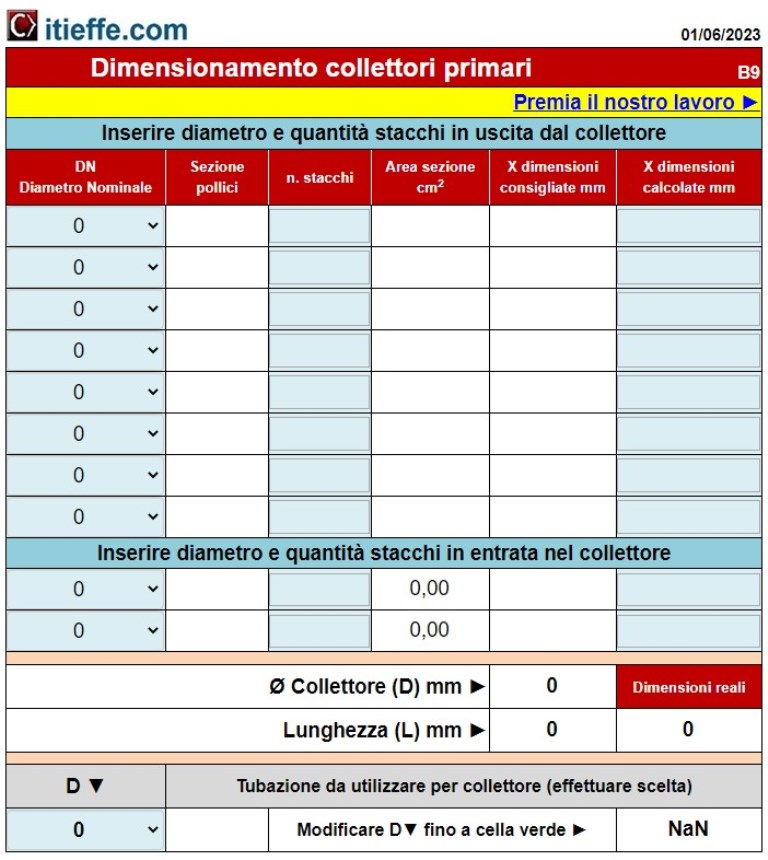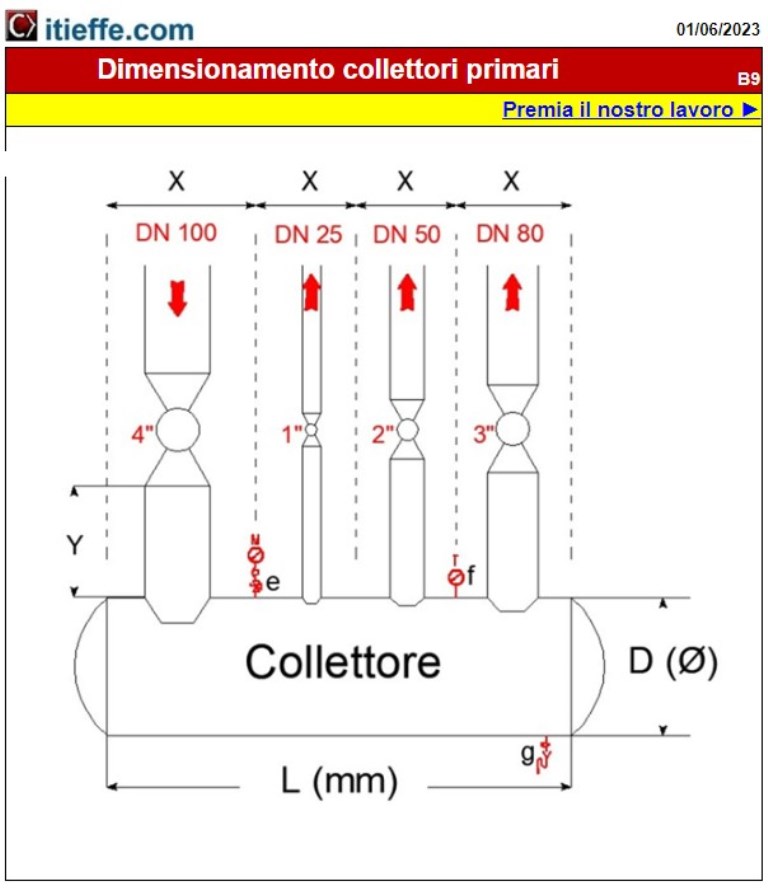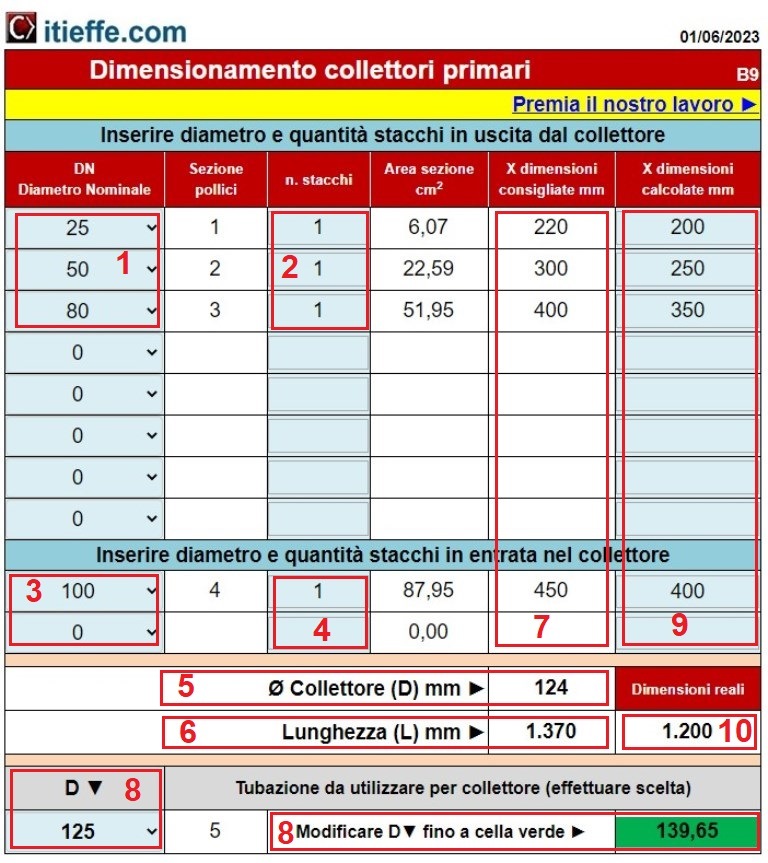Sizing of hydraulic primary manifolds

Calculation of dimensions of hydraulic primary manifold distribution of fluids
Primary collectors, also known as central or main collectors, represent the backbone of fluid distribution systems in buildings, industrial plants and infrastructure networks. These components are responsible for effectively transporting and distributing water, heat, refrigerant or other fluids to the points of use or heat exchange. Proper design and accurate sizing of primary manifolds are critical to ensuring optimal operation of the hydraulic system, minimizing pressure losses, reducing energy costs and ensuring long-term reliability.
The “Primary Collector Sizing” program was developed by Itieffe to support engineers, designers and operators responsible for the design and implementation of complex hydraulic networks. Its main features include:
- Calculation of collector dimensions: The program allows you to precisely calculate the dimensions required to meet the needs of the application. This is essential to ensure that each user or point of use receives the required amount of fluid.
- Entering the necessary pipe diameters: The program assists in selecting the appropriate pipe and header sizes based on previously calculated flow rates and other application-specific parameters.
- Number of sections: it is necessary for calculating the dimensions of the collector.
The design and sizing of primary collectors requires in-depth knowledge of fluid properties, flow dynamics and specific application needs. This program was developed to simplify and streamline this complex process, while ensuring that hydraulic networks operate efficiently, reliably and safely. Furthermore, it helps reduce waste of resources, both in terms of energy and material, and promotes efficiency in hydraulic systems, an increasingly important aspect in terms of sustainability and energy efficiency.
Sizing of primary manifolds (hydraulic, central or main)
Hydraulic manifolds are used to distribute and collect fluids (hot or refrigerated) from different circuits
Collectors can be classified into "area" and "primary".
Leaving aside the zone manifolds which are already sized and built by the factory, let's focus on the primary manifolds (also called main or central).
They are generally made and placed in thermal or refrigeration plants.
They function as distributors of the vector fluid which circulates in the various users such as: radiators, radiant panels, fan coils, unit heaters, air treatment units, etc.
The main collectors can be artificially made directly in the workshop or on site, by specialized thermal fitters.
For their realization we start from sections of pipe having specific diameters linked, obviously, to the water flow rates involved (see in this regard: Quick pipe size calculation).
For the sizing of the primary collectors, several factors must be taken into account:
- the maneuvering space of the shut-off valves
- the dimensions of the insulation and insulation
- the size of the spaces available in the exchange
- the ease of replacement of the various components relating to the manifold
This simple program provides general guidelines on how to make a primary manifold by calculating its diameter (D), the distance between the branches (X) and the total size of the building (L) both recommended and real.

Instructions for using the program

The program is easy to use and very immediate. It is valid for the calculation of manifold sizes up to 12 inches (DN 300):
1 – enter the nominal diameter (DN) of each individual manifold outlet calculated on the basis of the specifications it must have (see: Piping properties)
2 – enter the quantity of the number of outlets leaving the collector
3 – enter the nominal diameter (DN) of each single outlet entering the manifold calculated on the basis of the specifications it must have
4 – enter the quantity of the number of outlets entering the manifold
Once this is done, the program returns all the searched results:
5 – the diameter of the collector (D) in millimeters (see: Distance to length conversions)
6 – the length of the collector (L) in millimeters
7 – the recommended dimensions for each single outlet (X) both at the outlet and at the entrance to the manifold
8 – once section "D" has been found (see point 5), it is advisable to choose a pipe with the same or immediately greater diameter based on the diameters available on the market. In this regard, enter increasing values in the cell located below: "D ▼" until the carryover cell turns green.
9 – if you have the real dimensions of the manifold components available, you can enter the individual dimensions in millimeters directly in this section
10 – here is the real length of the manifold calculated with the real data entered by the operator
As always, it should be noted that the results provided by this program are to be understood as general indications.
The letters shown on the attached drawing indicate respectively:
D = collector diameter in millimetres
L = collector length in millimetres
X = recommended distance between the individual branches in millimetres. Always check according to the type of valve used, the levers and handwheels and the dimensions of the insulation for the insulation, if necessary, resize with real dimensions calculated by the operator
Y = distance of the valve connection from the manifold. It is advisable to leave it at least 130 ÷ 200 mm with reference to the larger size detachment. If there are flanged joints, the clearance must allow for the bolts to be pulled out
e = service pressure gauge – provide for standard ø ½” female gas couplings (see table)
f = service thermometer – provide for standard ø ½” gas female sleeve connections
g = discharge into sewer (DN 25)
Other free programs of the same kind offered by itieffe ▼
- Heating - Plumbing
- Pipelines
- Heating tables
- pumps
- Heating drawing diagrams
- Domestic hot water
- Combustible gases
Sizing of hydraulic primary manifolds
The program below is free to use.
To access the reserved version (see below), full page and without advertising, you must be registered.
You can register now by clicking HERE
